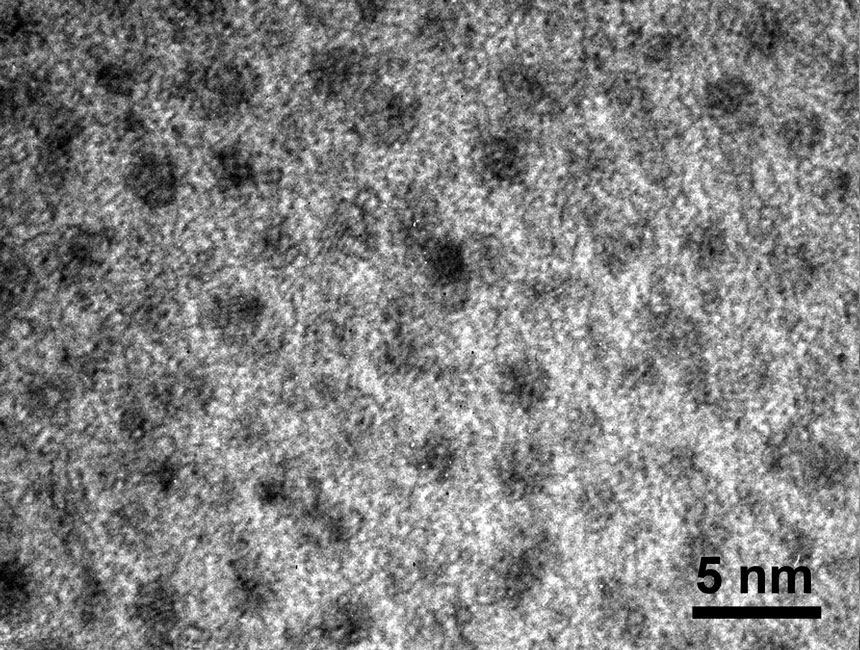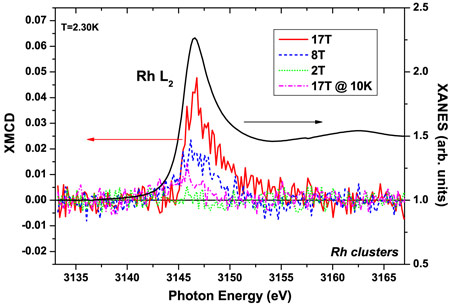- Home
- News
- Spotlight on Science
- XMCD reveals the...
XMCD reveals the magnetism of Rh clusters
11-12-2012
The type of magnetism exhibited by a material can be dependent on the size of the particle, with nanoscale clusters behaving differently to the bulk material. Rhodium clusters of around 150 atoms have been investigated using XMCD to examine the magnetic behaviour of itinerant electron systems close to the onset of stable ferromagnetism.
The source of magnetism in solids is the electrostatic repulsion between electrons. Due to the Pauli principle, the repulsion is reduced when their spins are parallel. However, for a parallel coupling between spins to happen, the electrons need to become more localised and this leads to an unwanted increase in their kinetic energy. In Fe, Co and Ni, elements belonging to the 3d transition series of the periodic table, the lower energy state is magnetic, whereas, for heavier elements belonging to the 4d or 5d transition series, the lowest energy state is non magnetic. The 4d metals Ru, Pd or Rh, exhibit Pauli paramagnetism, which means that the d-band becomes polarised under an applied magnetic field.
In very small clusters, electron bands tend to be narrower in energy than in bulk materials, a property inherently associated with the reduced number of neighbours. Consequently, the kinetic energy lost is less when displacing electrons from one sub-band with a given spin state to another with an opposite spin. This tends to favour magnetism for small cluster over bulk. Very small Rh clusters, containing up to 35 atoms, were shown to exhibit ferromagnetism as early as 1993 [1]. Subsequent theoretical and experimental studies indicated that stable ferromagnetism could persist up to around 100 atoms or more [2].
Physical systems characterised by the existence of two states of almost equal energy present an opportunity to learn by studying the competition between these states. Earlier descriptions of the properties of Rh made us realise that Rh clusters containing about 150 atoms could constitute a model system to study paramagnetism close to the onset of stable magnetism. Classically, clusters can be prepared by evaporating atoms from a target and letting them agglomerate “in-flight”. Under such conditions, the cluster size is typically below 50 atoms. One can deposit these clusters on a substrate, but they tend to agglomerate to sizes of about 1000 atoms. We used a different approach based on the implantation of Rh atoms in an insulating layer of alumina by using an ion accelerator at the Federal University of Rio de Janeiro (UFRJ). The clusters we obtained showed a diameter around 1.5 nm by transmission electron microscopy (Figure 1) and comprised about 150 atoms, as desired.
 |
|
Figure 1. TEM image of Rh clusters implanted in an alumina matrix. |
Magnetic characterisation using the most sensitive bulk magnetometry available (super conducting quantum interference device, SQUID) was not a success as the magnetic signal was systematically dominated by undesired signals from the substrate on which the alumina had been deposited and into which the Rh clusters were implanted. This led us to undertake an experiment using X-ray Magnetic Circular Dichroism (XMCD), a technique that combines element selectivity (allowing the measurement of the Rh signal alone) with extreme sensitivity. The XMCD signals measured at beamline ID12 for a variety of different experimental parameters are shown in Figure 2. At 2 K, the XMCD signal increases linearly with the field as expected for a paramagnetic system. However, the deduced magnetic susceptibility appears to be 20 times higher than the one due to the known Pauli paramagnetism of bulk Rh. Furthermore, the paramagnetic signal decreases very rapidly with temperature (the XMCD signal at 10 K under 17 T is much weaker than the one at 2 K) following an approximate 1/T law, instead of being almost temperature independent, as expected for Pauli paramagnetism.
 |
|
Figure 2. XMCD signal at the Rh L2 edge at 2 K, under a magnetic field of 2 T, 8 T and 17 T respectively and at 10 K under a magnetic field of 17 T. |
These results appear to confirm theoretical predictions made independently by Murata and Doniach [3] and by Moriya and Kawabata [4] in the 1970’s. They predicted a strong enhancement of the susceptibility close to the onset of stable magnetism due to correlations between electrons. With increasing temperature, spin-fluctuations (excitations of the moments having a certain collective character) become excited and the susceptibility consequently decreases. These predictions were awaiting confirmation due to the lack of systems to test them as well as to experimental difficulties. The unique combination of element selectivity of XMCD and low temperature and high magnetic field available at ID12 has been essential for the success of our experiment.
Principal publication and authors
Spin fluctuations of paramagnetic Rh clusters revealed by X-ray magnetic circular dichroism, V.M.T.S. Barthem (a), A. Rogalev (b), F. Wilhelm (b), M.M. Sant'Anna (a), S.L.A. Mello (a), Y. Zhang (c), P. Bayle-Guillemaud (d), D. Givord (a,c), Phys. Rev. Lett. 109, 197204 (2012).
(a) Instituto de Física, Universidade Federal do Rio de Janeiro (Brazil)
(b) ESRF
(c) Institut Néel, CNRS/UJF, Grenoble (France)
(d) CEA-INAC/UJF, SP2M, LEMMA, Minatec Grenoble (France)
References
[1] A.J. Cox, J.G. Louderback and L.A. Bloomfield, Phys. Rev. Lett. 71, 923-926 (1993); A.J. Cox, J.G. Louderback, S.E. Apsel and L.A. Bloomfield, Phys. Rev. B 49, 12295-12298 (1994).
[2] C. Barreteau, R. Guirado-Lopez, D. Spanjaard, M.C. Desjonqueres, and A.M. Oles, Phys. Rev. B 61, 7781-7794 (2000).
[3] K.K. Murata and S. Doniach, Phys. Rev. Lett. 29, 285-288 (1972).
[4] T. Moriya and A. Kawabata, J. Phys. Soc. Jpn. 34, 639-651 (1973).
Top image: XMCD signal at the Rh L2 edge.



